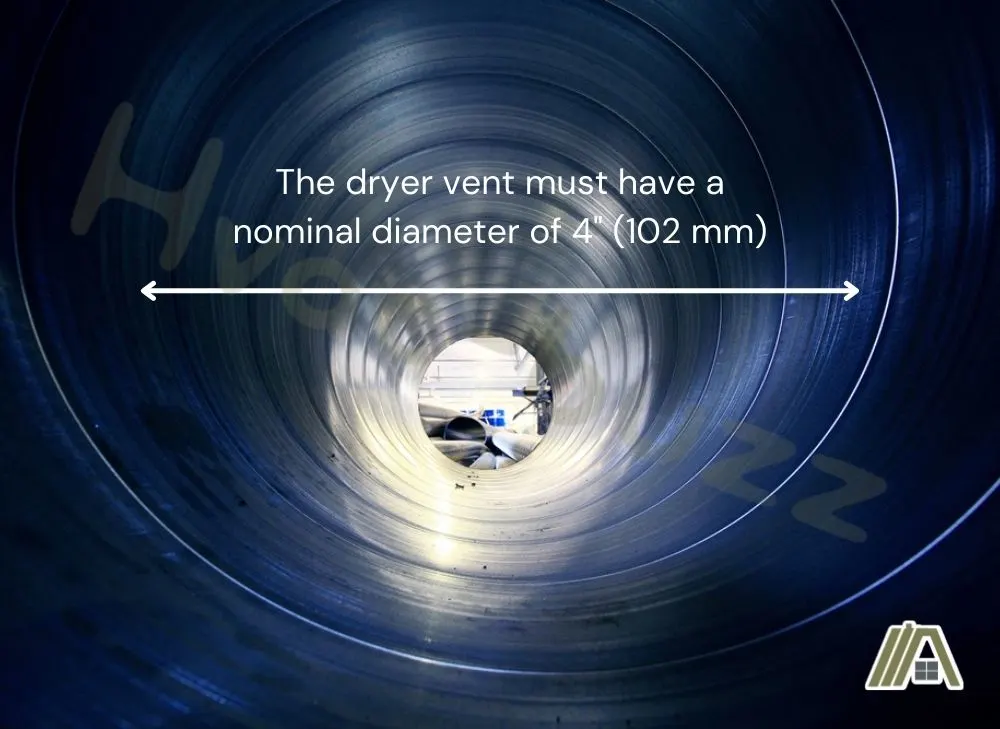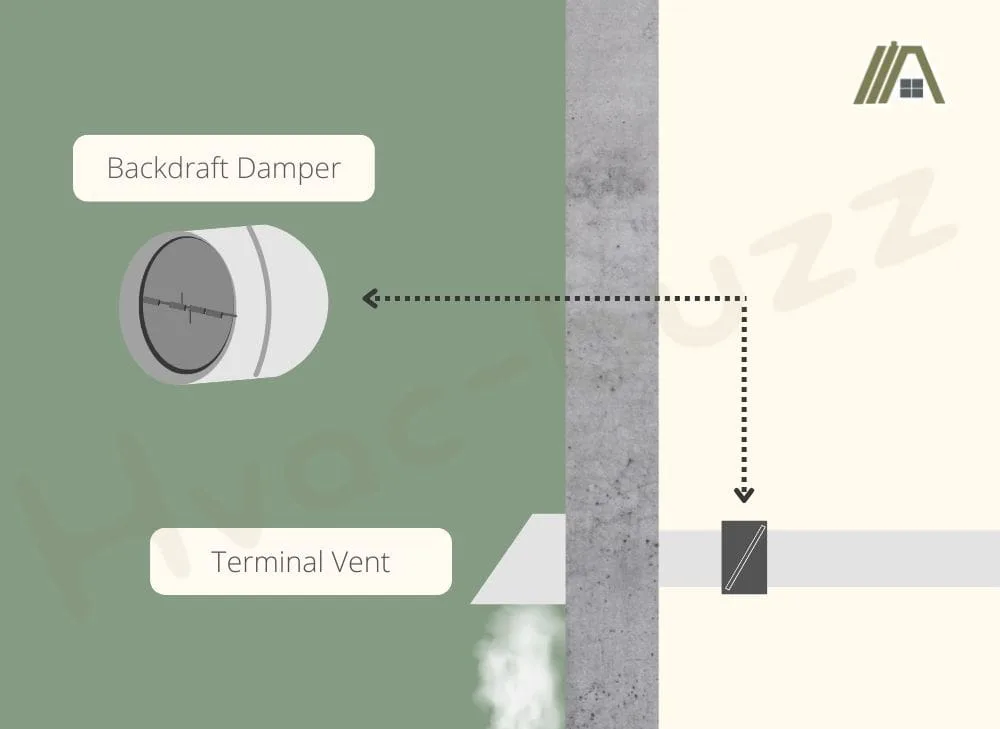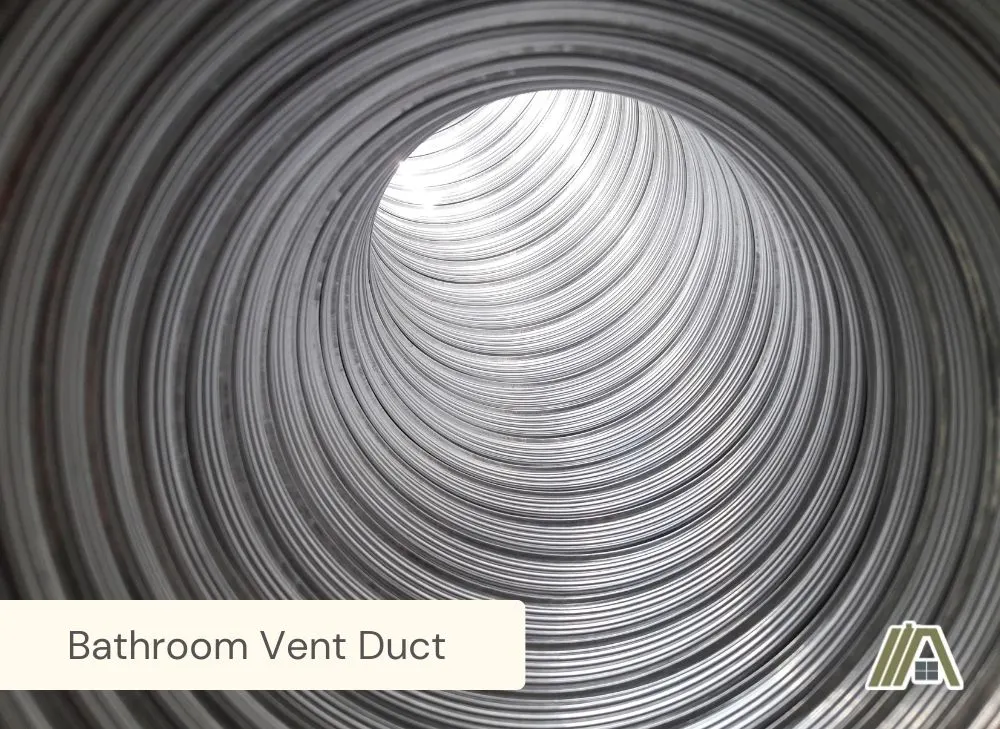
Dryer vents must be made of metal with a smooth interior surface and backdraft damper. Maximum length is 35 ft, and they cannot be screened. Bathroom vents can be made from different materials, including those with ridged interior surfaces. They can be screened, don’t need dampers, and can vent much further.
Difference Between Dryer and Bathroom Vents: Overview
Dryer vents and bathroom vents are similar in that their dimensions are regulated by the International Residential Code (IRC) and that they must vent to the outside of the house.
Possibly the most definitive difference between them is that dryer vents have to have a smooth interior surface while bathroom fan vents can be made from flexible ducting, which has a ridged interior surface.
What is a Dryer Vent?
Allowable Materials
According to Section M1502.4.1 of the IRC, a clothes dryer vent must be entirely constructed of metal. In addition, the code specifies a minimum thickness of 0.0157″ (0.3950 mm) for the metal.
Interior Surface
Clothes dryer vents are required by the IRC to be made with a smooth interior surface (Section M1502.4.1).
A smooth interior is specified to ensure the prevention of lint and moisture build up in the ductwork. If either of these were to accumulate in the dryer’s exhaust system, it could lead to serious damage to a person’s home and even risk to their safety (lint is flammable and mold is potentially toxic).
This requirement of a smooth interior surface immediately eliminates the possibility of using flexible ducting for dryers. Only rigid metal ducts are acceptable.
Length and Diameter
The dryer vent must have a nominal diameter of 4″ (102 mm) (Section M1502.4.1 ).

Because this is just a nominal diameter (i.e., there can be some variation), other diameters can be used safely, although these should be greater than 4″.
Overall, dryer ducts should never be any longer than 35 ft (10,668 mm) in length. This is the maximum allowable length specified in Section M1502.4.6.1 of the IRC.
This 35 ft is measured from the start of the transition duct, which connects the dryer itself to the ducting, to the duct’s final outlet or termination vent.
But the maximum allowable length is a little more complicated than just 35 ft. With every fitting added to the system (elbows), you have to subtract a certain length from this maximum. These reductions are listed in Table M1502.4.6.1 of the IRC.
Then again, if the manufacturer specifies a diameter and maximum allowable length, then you must preferentially follow these over the IRC guidelines. This caveat can be seen in Section M1502.4.6.2 of the IRC.
For more information, check out my Dryer Duct Length and Dimension Guide.
Joints, Support, and Installation
The information about joints, support, and installation for dryer vents can be found in Section M1502.4.2 of the IRC.
Here, it says the following:
- Dryer vents must be supported and secured into place at intervals of 12 ft (3,658 mm) or less.
- The ducts must be connected so that the insert portion of the join slides into the next section following the direction in which air will be traveling.
- Joints must be fastened mechanically but the fasteners cannot extend higher than 1/8″ (3.2 mm) into the duct’s interior.
- Joints must be sealed with welds, gaskets, mastic, mastic/fabric systems, liquid sealant, or tape (Section M1601.4.1).
- In addition, if a dryer duct is being installed in a place where it’s surrounded by walls or other surfaces, it must be able to be installed easily without damaging the duct.
Backdraft Damper and Screen
As mentioned in the overview, dryers have to vent outside. At the terminal vent, there has to be a backdraft damper installed, but a screen is not permitted (Section M1502.3).

The backdraft damper stops exhausted air from blowing back into the ducts. The prohibition of the screen is to ensure that the lint is not trapped against the terminal vent, causing blockages.
What is a Bathroom Vent?
Allowable Materials
Bathroom vents have a bit more freedom when it comes to allowable materials. The main requirement is that the material must have a flame spread index smaller than 200.
Named allowable materials (Section M1601.1.1 and Section M1601.1.2) include metal, flexi-duct, fibrous glass, and plastic.
The IRC provides a chart, Table M1601.1.1, to determine the thickness needed for ducts. These figures range from 0.013″ to 0.034″. The chart is based on the material used, static pressure, the duct’s diameter, and the shape of the duct.
Interior Surface
The interior surface of bathroom vents can be smooth or ridged because metal, plastic, and aluminum flex ducts are permitted to be used.
Smooth surfaces aren’t as important in bathroom vents because bathroom fans do not exhaust flammable lint and the temperatures passing through the ducts are much lower than for dryers, making any potential obstructions less dangerous.
Length and Diameter
For bathroom vents, there are no explicit length and diameter requirements in the IRC.

However, looking at Table M1601.1.1 and Table M1504.2, we can see that diameters be between 3″ and 20″ and the maximum length is listed as 198 ft (but this is under specific circumstances).
The correct sizing for bathroom ducts depends on manufacturer instructions (Section M1504.2) or on the duct type, fan rating, and diameter (in the case of length) as per the code.
Similarly to dryer ducts, each elbow reduces the allowable length. However, in dryers, this amount varied according to elbow type. For bathroom fan vents, each elbow is equivalent to 15 ft.
Joints, Support, and Installation
According to Section M1601.4.1, bathroom fan vent joint construction, seals, and connections are regulated by:
- SMACNA HVAC Duct Construction Standards—Metal and Flexible
- NAIMA Fibrous Glass Duct Construction Standards
- UL 181A
- UL181B
When it comes to installation, there are many highly specific requirements for bathroom vents depending on if they meet certain standards (too detailed for the purposes of this article). In comparison, the installation requirements of dryer ducts are less detailed.
Backdraft Damper and Screen
There is no requirement for bathroom ducts to have a backdraft damper. However, if there is one, it must be accessible.
In addition, there are no restrictions for bathroom ducts regarding screens where the duct terminates, so bathroom vents may have a screen where the duct terminates.
Table of Differences Between Dryer and Bathroom Vents
| Feature | Dryer Vents | Bathroom Vents |
| Material | Must be metal | Can be metal, fibrous glass, or PVC. |
| Duct Wall Thickness | > 0.0157″ | 0.013-0.034″ |
| Interior Surface | Must be smooth | Can be smooth or ridged |
| Diameter | 4″ (nominal) | Manufacturer specifications or 3-20″ |
| Length | Manufacturer specifications or less than 35 ft | Manufacturer specification or up to 198 ft (certain conditions) |
| Backdraft Damper | Required | Not mandatory |
| Terminal Vent Screen | Prohibited | Allowed |
Can One Be Used in Place of the Other?
You can use a dryer vent for a bathroom fan as a bathroom duct can have any type of surface on the inside.
However, you can’t do the opposite unless the bathroom vent has a smooth interior surface, as this is necessary for a dryer vent.
The lengths and diameters would also have to be assessed to see if they meet the requirements for the other exhaust system.
In addition, it’s important to note that a bathroom fan and dryer cannot share a vent under any circumstances.
The IRC prohibits dryer vents from being connected to any other duct systems due to the possible hazards that will be caused by particle buildup as a result.
Sources
https://codes.iccsafe.org/content/IRC2021P1/chapter-15-exhaust-systems
https://codes.iccsafe.org/content/IRC2021P1/chapter-16-duct-systems

